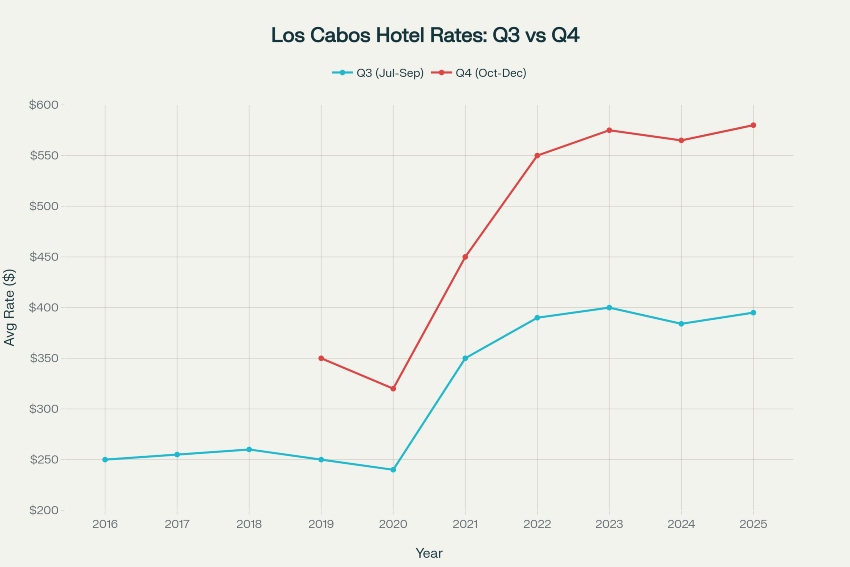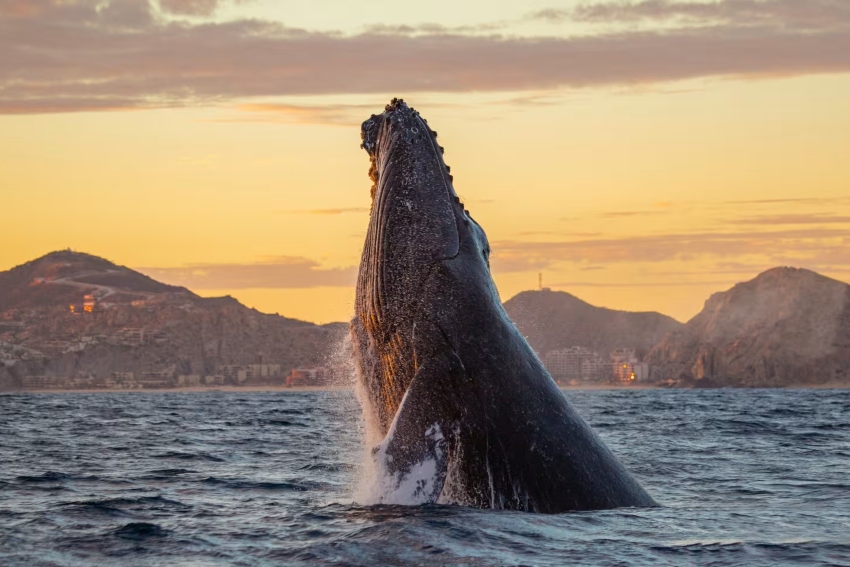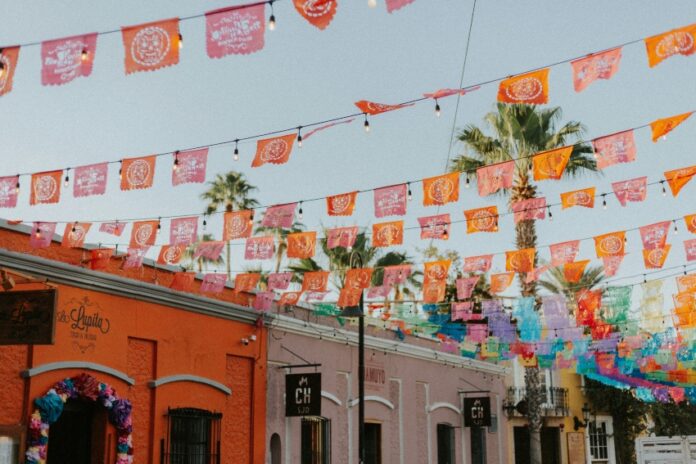Los Cabos has become a more year-round destination in recent years, and the numbers support this trend. The summer months, traditionally the heart of Los Cabos’ slow tourism season, have seen increasing numbers of visitors over the past decade. In 2016, only 450,000 tourists arrived between July and September. By 2024, according to Fideicomiso de Turismo de Los Cabos (FITURCA), that figure had grown to 800,000.
Yes, tourism has also increased during high season, which runs from October through May, with its absolute peak between December and March. Taking only the period from October to December, for example, tourism grew from 710,000 in 2016 to 1.31 million in 2024. But tourism in the fall and winter no longer outperforms summer as convincingly as it has in the past, and the gap between these seasons has been gradually shrinking. It’s not all snowbirds anymore, in other words.

Even with the shrinking gap, however, these numbers present a powerful argument that high season still matters. With that in mind, here are five reasons to celebrate the arrival of October in Los Cabos and the return of high season.
Changing weather
As September turns to October, several welcome changes occur: the temperature drops (from an average of 85 degrees Fahrenheit to 82), humidity lessens and sunshine increases due to decreased precipitation levels and chances of tropical storms.
The weather difference is even starker if we view it from a larger lens, comparing the period of July-September versus that of October-December. In the latter calendar window, humidity drops significantly (from 73.3% to 56.3%) as do average temperatures (from 84 degrees to 75.7), while the 90+ degree highs of July and August give way to daily highs in the mid to low 80s.
Keep in mind that this transition to glorious weather is taking place as temperatures are cooling precipitously in the U.S. and much of Canada as winter arrives, and it’s easy to see how and why the traditional high season developed as it has. Particularly, when one considers that even in December, water temperatures in Los Cabos average 75 degrees and are comfortable for swimming, diving and other activities.
Changing hotel rates
One of the most significant reasons that high season in Los Cabos still matters is that the difference in average hotel rates between high season and low has never been wider. It bears noting that rates have gone up significantly across the board since the pre-pandemic era, with the average daily rate (ADR) climbing precipitously in the space of a few short years.
However, if we compare the third and fourth quarters (July-September vs. October-December), it’s clear that the former still offers significant attractions from a budgetary perspective. Yes, rates in the third quarter have increased by 53.6% since 2019. But high-season rates in October-December have gone up by 61.4% during the same six-year stretch.

If you’re wondering, Los Cabos boasts the highest hotel rates on average in Mexico, a reflection of its ongoing rebranding as a luxury destination. September remains the most affordable time to book, as once October arrives, rates begin rising. In 2024, for example, per FITURCA data, ADR during the third quarter was $381, as compared to $441 in the fourth. So rates went up by about $60, a premium pricing uptick of 16.4% to meet increased demand during high tourist season.
More big events
There are a few big events during the summer months, but almost none during August and September. The seasonal event calendar kickstarts in earnest in October, with a spate of heavyweight happenings, and this momentum continues throughout high season.
Some weren’t intentionally scheduled to take advantage of the season. Sammy Hagar’s annual birthday bashes at Cabo Wabo Cantina – a major draw for over 30 years – are based on the Red Rocker’s birthdate (Oct. 13). It’s a happy accident. However, the fact that the biggest fishing tournaments, including Bisbee’s Black and Blue, with the world’s richest payouts, take place in October has everything to do with seasonal weather conditions (and the fact that there is less chance of tropical storms in October than in September).
More specifically attuned to increasing tourism, meanwhile, is Art Walk in San José del Cabo, a high-season cultural staple since 2006. Each year, this event returns contemporaneously with Day of the Dead festivities at the beginning of November – an occasion for artistic ofrendas – with locals and tourists alike gathering each Thursday evening through June to walk the cobblestone streets and explore the galleries, shops, restaurants and bars of the historic Gallery District.
Whale watching season
Of course, the biggest of big events, literally and figuratively, is whale watching season. It runs each year from Dec. 15 to April 15 and has become not only a bucket-list activity but also a major economic driver for the destination.
It wasn’t always like this. Whale watching wasn’t formally introduced as a tourist activity in Los Cabos until 1980, helped along by new permitting procedures from Mexico’s Secretariat of Environment and Natural Resources (SEMARNAT). Still, it would take a while for the nascent industry to take hold. By February 2016, there were 35 permitted ecotourism operators in Cabo San Lucas and six in San José del Cabo. Meanwhile, between 2010 and 2019, profits from whale watching increased exponentially, from $388,622 locally to nearly $3 million ($2,911,010, to be exact).

These numbers have only continued to grow. Nowadays, an estimated 50,000 visitors per year participate in seasonal whale-watching activities, forming a crucial component of the destination’s tourism economy, both generally and specifically as the highlight of its marine ecotourism offerings. That whale watching season runs concurrently with the height of high season in Los Cabos is yet another reason why such seasonal distinctions still matter.
Chris Sands is the former Cabo San Lucas local expert for the USA Today travel website 10 Best and writer of Fodor’s Los Cabos travel guidebook. He’s also a contributor to numerous websites and publications, including Tasting Table, Marriott Bonvoy Traveler, Forbes Travel Guide, Porthole Cruise, Cabo Living and Mexico News Daily.
